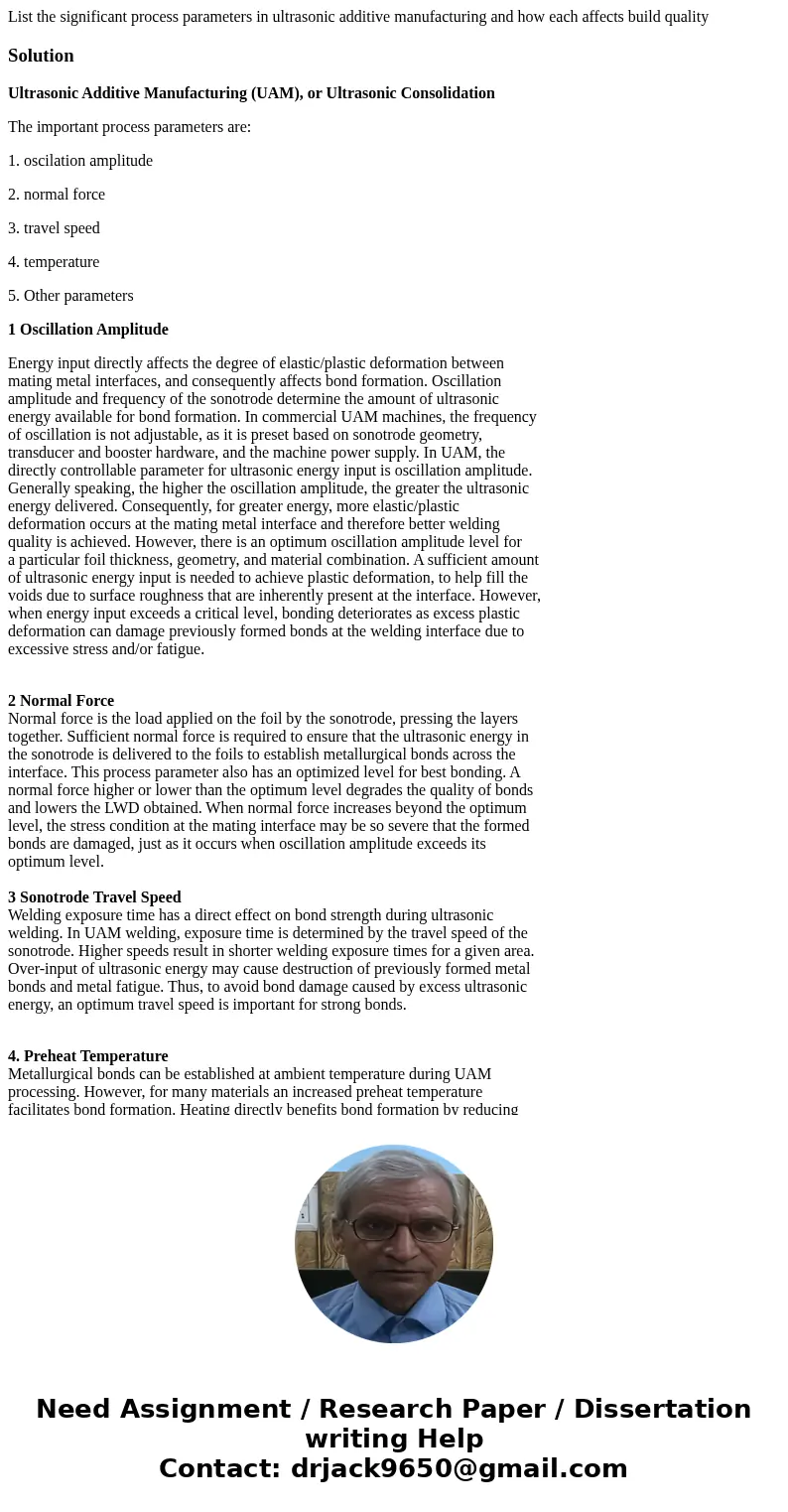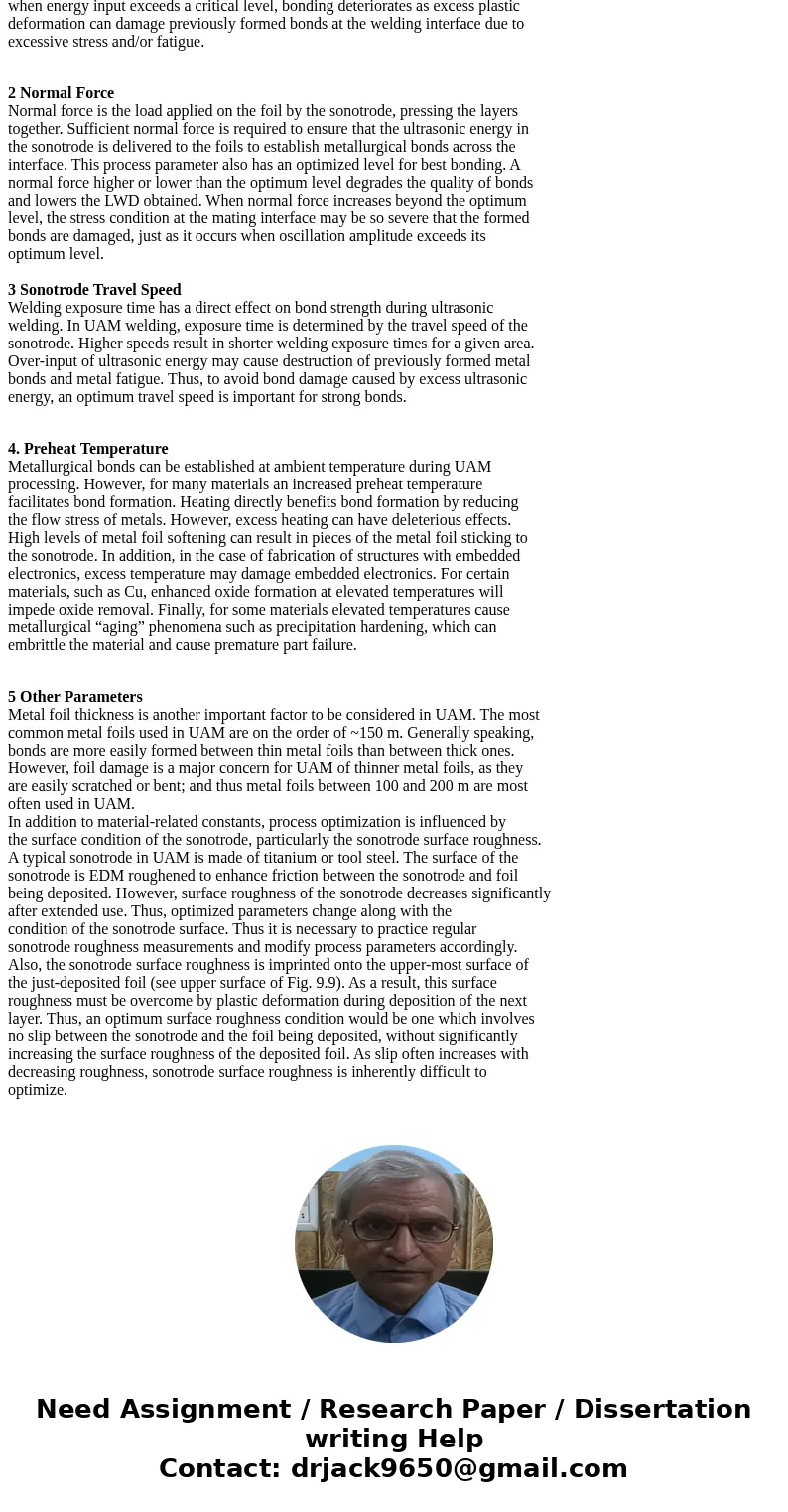List the significant process parameters in ultrasonic additi
List the significant process parameters in ultrasonic additive manufacturing and how each affects build quality
Solution
Ultrasonic Additive Manufacturing (UAM), or Ultrasonic Consolidation
The important process parameters are:
1. oscilation amplitude
2. normal force
3. travel speed
4. temperature
5. Other parameters
1 Oscillation Amplitude
Energy input directly affects the degree of elastic/plastic deformation between
mating metal interfaces, and consequently affects bond formation. Oscillation
amplitude and frequency of the sonotrode determine the amount of ultrasonic
energy available for bond formation. In commercial UAM machines, the frequency
of oscillation is not adjustable, as it is preset based on sonotrode geometry,
transducer and booster hardware, and the machine power supply. In UAM, the
directly controllable parameter for ultrasonic energy input is oscillation amplitude.
Generally speaking, the higher the oscillation amplitude, the greater the ultrasonic
energy delivered. Consequently, for greater energy, more elastic/plastic
deformation occurs at the mating metal interface and therefore better welding
quality is achieved. However, there is an optimum oscillation amplitude level for
a particular foil thickness, geometry, and material combination. A sufficient amount
of ultrasonic energy input is needed to achieve plastic deformation, to help fill the
voids due to surface roughness that are inherently present at the interface. However,
when energy input exceeds a critical level, bonding deteriorates as excess plastic
deformation can damage previously formed bonds at the welding interface due to
excessive stress and/or fatigue.
2 Normal Force
Normal force is the load applied on the foil by the sonotrode, pressing the layers
together. Sufficient normal force is required to ensure that the ultrasonic energy in
the sonotrode is delivered to the foils to establish metallurgical bonds across the
interface. This process parameter also has an optimized level for best bonding. A
normal force higher or lower than the optimum level degrades the quality of bonds
and lowers the LWD obtained. When normal force increases beyond the optimum
level, the stress condition at the mating interface may be so severe that the formed
bonds are damaged, just as it occurs when oscillation amplitude exceeds its
optimum level.
3 Sonotrode Travel Speed
Welding exposure time has a direct effect on bond strength during ultrasonic
welding. In UAM welding, exposure time is determined by the travel speed of the
sonotrode. Higher speeds result in shorter welding exposure times for a given area.
Over-input of ultrasonic energy may cause destruction of previously formed metal
bonds and metal fatigue. Thus, to avoid bond damage caused by excess ultrasonic
energy, an optimum travel speed is important for strong bonds.
4. Preheat Temperature
Metallurgical bonds can be established at ambient temperature during UAM
processing. However, for many materials an increased preheat temperature
facilitates bond formation. Heating directly benefits bond formation by reducing
the flow stress of metals. However, excess heating can have deleterious effects.
High levels of metal foil softening can result in pieces of the metal foil sticking to
the sonotrode. In addition, in the case of fabrication of structures with embedded
electronics, excess temperature may damage embedded electronics. For certain
materials, such as Cu, enhanced oxide formation at elevated temperatures will
impede oxide removal. Finally, for some materials elevated temperatures cause
metallurgical “aging” phenomena such as precipitation hardening, which can
embrittle the material and cause premature part failure.
5 Other Parameters
Metal foil thickness is another important factor to be considered in UAM. The most
common metal foils used in UAM are on the order of ~150 m. Generally speaking,
bonds are more easily formed between thin metal foils than between thick ones.
However, foil damage is a major concern for UAM of thinner metal foils, as they
are easily scratched or bent; and thus metal foils between 100 and 200 m are most
often used in UAM.
In addition to material-related constants, process optimization is influenced by
the surface condition of the sonotrode, particularly the sonotrode surface roughness.
A typical sonotrode in UAM is made of titanium or tool steel. The surface of the
sonotrode is EDM roughened to enhance friction between the sonotrode and foil
being deposited. However, surface roughness of the sonotrode decreases significantly
after extended use. Thus, optimized parameters change along with the
condition of the sonotrode surface. Thus it is necessary to practice regular
sonotrode roughness measurements and modify process parameters accordingly.
Also, the sonotrode surface roughness is imprinted onto the upper-most surface of
the just-deposited foil (see upper surface of Fig. 9.9). As a result, this surface
roughness must be overcome by plastic deformation during deposition of the next
layer. Thus, an optimum surface roughness condition would be one which involves
no slip between the sonotrode and the foil being deposited, without significantly
increasing the surface roughness of the deposited foil. As slip often increases with
decreasing roughness, sonotrode surface roughness is inherently difficult to
optimize.


 Homework Sourse
Homework Sourse